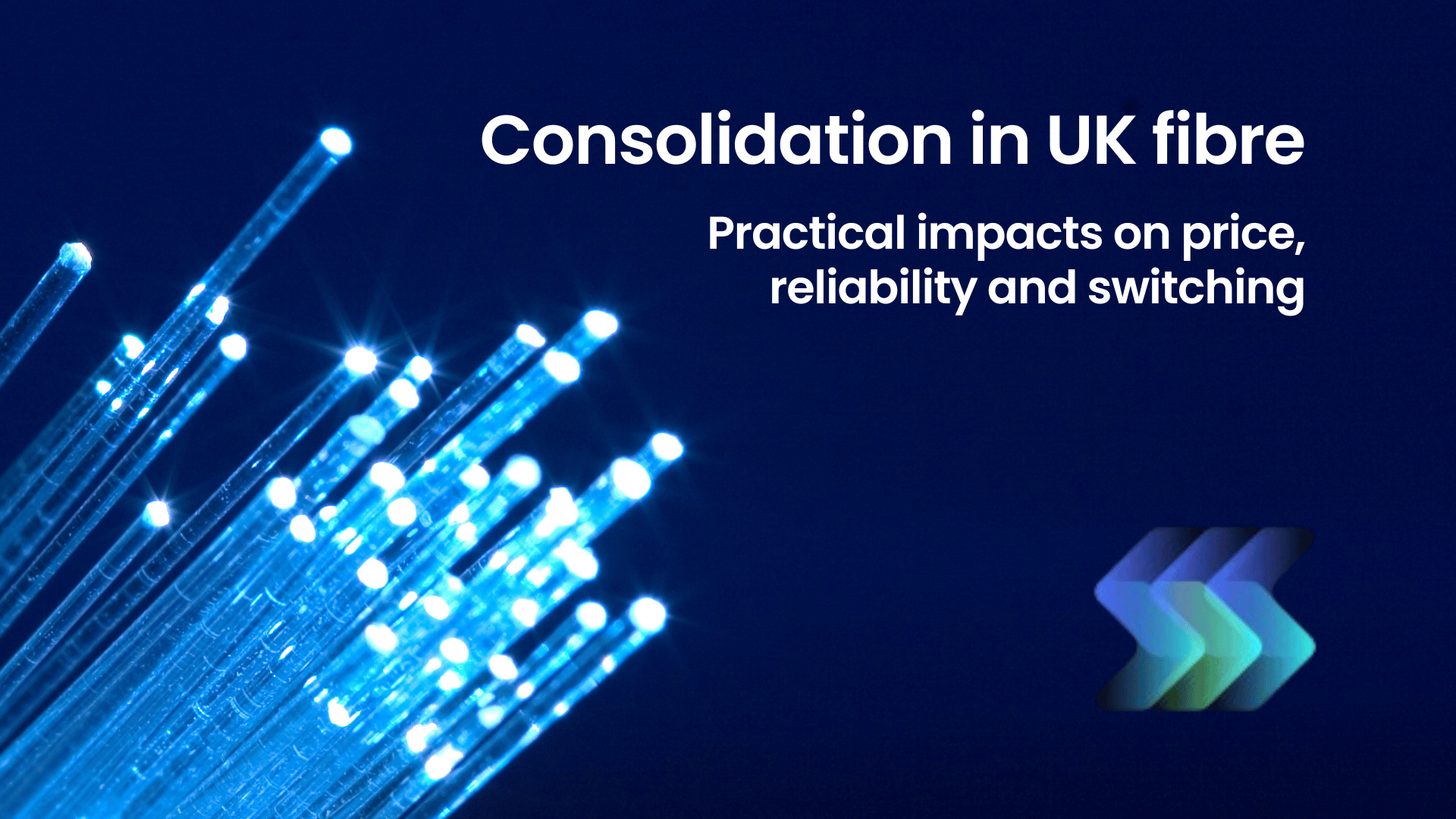Read the full interview on ISPreview UK: Rob Bradley on consolidation and fixing the turbulent UK fibre broadband market.
UK full fibre has grown fast. What is changing now, as Rob Bradley explains in this excellent ISPreview interview, is the focus. The industry is moving from a build race to a take‑up race. That shift is pushing a wave of mergers and tighter execution around customer experience, operations and pricing. Below is a my simple view of the piece, followed by a short, practical take on what it means for households.
Key points from the ISPreview interview
- The market was built on speed of rollout. Many alternative networks (the industry speak for this is ‘alt nets’) were funded to pass as many homes as possible, quickly. The assumption was that customers would switch soon after build. In practice, adoption has been slower than planned.
- There are too many overlapping networks chasing the same streets. That creates duplicated cost and spreads demand thinly. The correction is consolidation, with fewer platforms covering larger areas and focusing on connections, not just coverage.
- Deals are hard because of valuation gaps and integration complexity. Sellers often anchor on peak‑era valuations. Buyers now price on real take‑up, cost‑to‑serve and the cost of integrating systems and teams.
- Winners will combine solid unit economics with proven integration capability. Low debt, experienced leadership, scalable IT stacks and minimal exposure to heavy overbuild are all markers of resilience.
- By 2030 the structure will likely be 4 to 5 large infrastructure owners plus many retail brands riding on top. In the hardest‑to‑reach places, satellite may sensibly fill remaining gaps.
Fast facts that help frame the interview
- Coverage is high, take‑up lags. By H1 2025, full fibre reached about 78.06% of UK premises, and gigabit‑capable services about 87.84%.
Source: ISPreview UK H1 2025 coverage summary. - Alt‑nets pass a lot of homes. Independent networks pass around 16.4 million premises, or ~15.2 million when you remove alt‑net overbuild.
Source: INCA and Point Topic 2025 report. - Switching is easier than before. Ofcom’s One Touch Switch has enabled around 1.6 million broadband or landline switches in its first year.
Source: Ofcom. - Analogue landlines are being retired. The PSTN is due to be switched off by 31 January 2027. That does not automatically remove copper broadband, but voice becomes digital and needs a backup power source (think old phones were powered by the copper, so in emergencies, if the power was out the phone would still work – the same should remain with this new technology).
Sources: Ofcom and UK Government guidance.
Editorial take: what this means for UK consumers
This section is clearly marked as commentary. It is a short, practical view to help readers act on the interview’s themes.
- Expect strong deals today where networks overlap, and steadier pricing later. While brands compete on the same streets you will keep seeing sharp introductory offers. As platforms merge, the extreme promos may cool, but service quality should stabilise. I’m seeing that new entrants to the sector are pricing low, so in fact that it has to be a loss lead – the problem a lot of new ISPs face is that they lack buying power (because of their small size) to negotiate strong wholesale rates, so are loosing money in order to build their book of business in the hope they survive long-enough to make a profit (this is a real example of chicken and egg in the UK technology space).
- Switching is now low‑hassle. Use One Touch Switch so your new provider handles the transfer date. Ask about compensation if you lose service during the switch. This reduces the risk of paying for two lines.
- Focus on connection, not headline speed. If your household streams, games and works from home, a 150 to 300 Mbps full fibre package is often more than enough. The key upgrade is reliability and upload speed, not just the biggest number on the page. If you don’t know what ‘speed’ you actually need then this free tool askes you a few questions then tells you – check it out here.
- If you rely on a home phone, ask for resilience. With digital voice you will need power. Vulnerable users and those with telecare should request battery backup or a mobile fallback.
- Re‑check availability before you renew. New wholesale agreements mean your preferred ISP might now be available on a different network at your address.
How to choose in under 5 minutes
- Run an availability check with your current provider and at least one rival network in your postcode. We have a solution you can use for free where you can input your postcode and see what options you have from circa 30 UK ISPs including all the top providers like BT, Virgin Media, Sky as well as new entrants like Rise Broadband. Access it here.
- Compare the total cost over the contract, not just the first 6 to 12 months.
- Look for clear policies on mid‑contract price changes and exit fees.
- If you need a landline, confirm the backup options during power cuts.
References (APA style)
- Jackson, M. (2025, 23 August). Rob Bradley on consolidation and fixing the turbulent UK fibre broadband market. ISPreview UK. https://www.ispreview.co.uk/index.php/2025/08/rob-bradley-on-consolidation-and-fixing-the-turbulent-uk-fibre-broadband-market.html
- Independent Networks Co‑operative Association, & Point Topic. (2025, April). Metrics for the UK independent network sector 2025. https://inca.coop/wp-content/uploads/2025/04/INCA-Point-Topic-April-25-1-1.pdf
- ISPreview UK. (2025, 30 June). Coverage of gigabit broadband nears 88 percent of UK in H1 2025. https://www.ispreview.co.uk/index.php/2025/06/uk-coverage-of-gigabit-broadband-nears-88-percent-in-first-half-of-2025.html
- Ofcom. (2025, 12 September). 1.6 million Brits hit switch on their landline or broadband provider. https://www.ofcom.org.uk/phones-and-broadband/switching-provider/1.6-million-brits-hit-switch-on-their-broadband-provider
- Ofcom. (2024, 7 February). Moving landline phones to digital technology. https://www.ofcom.org.uk/phones-and-broadband/landline-phones/future-of-landline-calls
- UK Government. (2023, 6 January). UK transition from analogue to digital landlines. https://www.gov.uk/guidance/uk-transition-from-analogue-to-digital-landlines
- CityFibre. (2024, 14 May). CityFibre completes its acquisition of Lit Fibre. https://cityfibre.com/news/cityfibre-completes-its-acquisition-of-lit-fibre
- Zzoomm. (2025, 27 January). FullFibre and Zzoomm merge to form one of the UK’s largest altnets. https://zzoomm.com/fullfibre-and-zzoomm-merge-to-form-one-of-uks-largest-altnets-with-600000-ready-to-serve-properties-and-over-65000-customers


